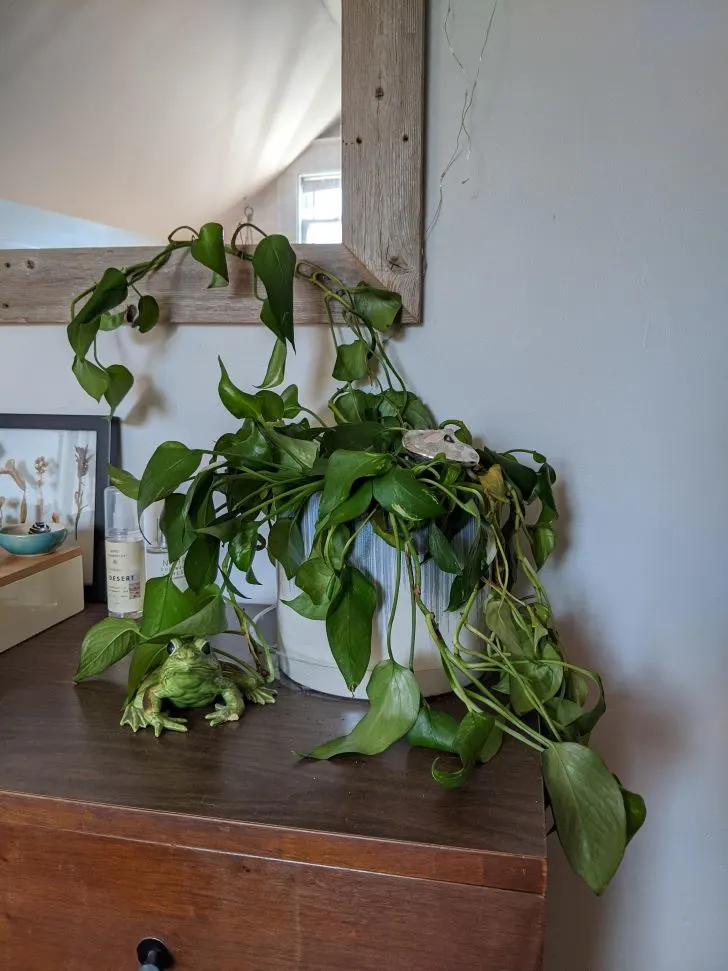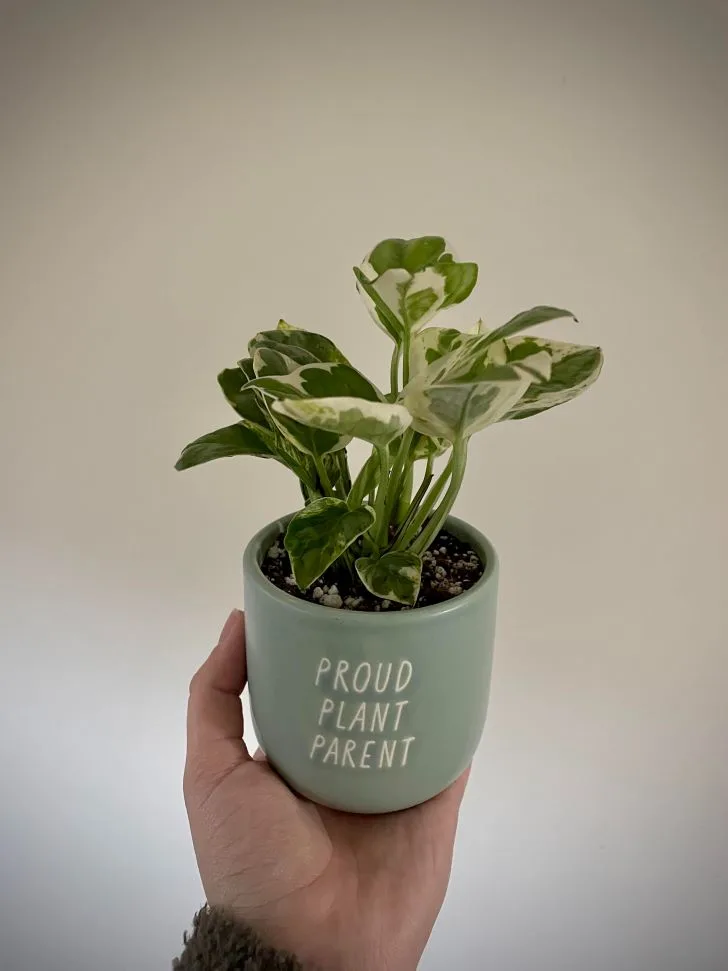Due to their attractive foliage and minimal maintenance, Pothos are one of the most popular houseplants grown worldwide.
Although their heart-shaped leaves and climbing vines are considered pretty hardy, these undemandingly manageable plants can sometimes experience problems like drooping and wilting.
The fact that you are here means you are going through the same problem.
Why is my Pothos wilting, you say? It’s time to stop worrying about that because we have the solution for you!
Today, in this article, we will discuss the factors that cause wilting in your Pothos plants.
Moreover, we’ll see how you can restore your plant to its optimum health.
So, without further ado, let’s jump in!

Why Is My Pothos Wilting? | The Reasons!
First things first, you can fix your wilting Pothos if you provide them with proper care.
Various reasons can cause your Pothos to wilt.
It could be because of the environment in which your Pothos is growing, it can be an improper watering schedule, or maybe, it indicates the owner’s negligence.
Let’s discuss all the reasons in detail!
1. Improper Watering Routine
Wilting leaves are a sign that your Pothos is under stress.
Poor hydration is one of the significant factors that contribute to plant stress.
Your Pothos won’t wilt if you just skip 1 or 2 watering sessions; it will be caused by long-term negligence.
Listen!
Water is needed to maintain the turgor pressure and health of the plant. If your plant is dehydrated, it loses its turgidity and appears wilted. Moreover, if there is not enough water in the soil, the plant won’t be able to absorb nutrients, resulting in yellow leaves.
Typically, older leaves show signs of wilting, but if young leaves also appear wilted, your plant needs more water.
So, is underwatering the only water-related problem for Pothos?
No!
Overwatering your Pothos can also cause leaves to become limp and yellow.
How? When you overwater your plants, the roots won’t be able to breathe, resulting in loss of diffusion and more chances of diseases. Consequently, the roots will die and won’t be able to absorb nutrients, resulting in a limp and yellow plant.
In the case of underwatering, the wilted leaves are dry and crisp, while in the case of overwatering, the leaves are soft and mushy.
2. Inadequate Humidity
Pothos plants are native to Southeast Asia. That’s why they grow best in humid climates.
Pothos require 50–70 percent humidity levels to grow at their peak potential. Their leaves are more likely to wilt if the humidity levels drop below 50 percent.
That type of situation can occur during the summer season or if there is a sudden drop in your room’s weather.
3. Cold Weather Conditions
As mentioned above, Pothos plants originate from Asia.
Therefore, they are well adapted to warm climates and are not frost tolerant.
If you expose them to cold temperatures, it can cause damage to your Pothos.
The optimal temperature for the Pothos plant is between 15–29°C (when it goes down, leaves become crispy and brown).
But how can you identify that cold is the problem?
Take a look at the soil. If it is not too dry or wet, your plant is wilting, and your outside temperature is under 10°C, frost is most probably the culprit!
4. Direct Sunlight
Although pothos plants prefer bright light, ensure that the provided sunlight is indirect.
Pothos cannot tolerate direct sunlight for a long time.
Too much direct sunlight increases the evaporation rate, reduces humidity, and decreases turgidity.
These factors lead to wilting.
5. Small Pots
Are you aware that your Pothos might be root-bound?
As a plant parent, you should understand that plants need ample space to grow, and as roots keep spreading through the soil, they’ll ultimately take all the available space.
That results in a root-bound plant.
It occurs when the roots are outgrown and tightly packed together; this prevents them from absorbing water and nutrients from the soil.
Ultimately, deprived of the required fuel, the plant wilts.

6. Nutrient Deficiency
Although Pothos plants demand little maintenance, they still require essential nutrients.
Lack of nitrogen, phosphorus, and potassium can cause the leaves to turn yellow or brown and causes wilting.
7. Transplantation Shock
Like other factors, transplantation shock can also cause the plant to wilt or droop.
Your plant might suffer from transplantation shock if you’ve recently brought it home from a greenhouse or transported it to a different location in your home.
It is usual for a newly transplanted pothos to experience wilting or drooping for a few days to a week after transplanting.
But if the wilting persists beyond this time, it may be a sign of some other problems.
8. Pest Infestations
Pest infestation is a common problem in Pothos plants.
These overweening pests attack your Pothos when they are weak. Your plants can become the target of these gardening pests if you are not careful.
Here are some common pests that can infest your Pothos plants:
Spider Mites
Spider mites are a nightmare for indoor gardeners.
These oval-shaped pests are only 4 mm and can be easily seen with a microscope. Infected leaves show symptoms like white webs, yellow/white dots on leaves, curling or burning leaf margin, and wilting.
Mealybugs
Mealybugs are tiny insects that look like cotton balls and are visible to the naked eye. If you look closely, you will mostly find them hidden under the leaves. They attract mold, leaving your Pothos stunned, looking sad and limp.
Fungus Gnats
Fungus gnats are small, winged insects that usually appear black. They mostly lay eggs in the soil, and their larvae feed on roots. It can cause wilting of leaves in Pothos plants.
That was all about: “Why is my Pothos wilting?”
Now, it’s time to see how you can revive your wilted Pothos.
How Can You Revive Your Wilted Pothos?
I hope you have understood the reasons for wilting Pothos.
Now it is time to move toward the solutions!
Watering
Do not let the soil dry out if underwatering is the cause. Also, make sure not to soak your soil by overwatering it.
To save your plant, these are some tips to follow:
- Check the moisture; water your Pothos evenly for around two inches if dry.
- Remove the damaged leaves.
- Carefully take the plant out of the pot.
- If the roots appear healthy, there is no need to re-pot your plant. Just take care of the watering schedule and let the top few inches of the soil dry out between waterings.
- If the roots appear black and mushy, it’s root rot. If so, you must re-pot your plant in a fresh potting mix.
- Select a pot with a good number of drainage holes at the bottom.
Follow these points to revive your plants quickly if they are dehydrated or overhydrated.
Humidity
Are the humidity levels of your home enough for your Pothos to grow well?
Here are some tips for you to increase the moisture levels in your home:
- Use a Humidifier: A humidifier is the most straightforward way to increase humidity levels in an area. Just plug in the humidifier and let it do its magic until you get your desired results.
- Occasional Misting: Misting your plants can help increase the surrounding humidity levels for some time.
- Use Pebble Tray: Placing your plant pot on a pebble tray filled with water can also increase the surrounding moisture levels to some extent.
- Placing your plants near more humid areas like a bathroom or a kitchen will help.
- Lastly, keeping all your tropical, moisture-loving plants in the same place will keep the humidity levels high around the plants.
Now, let’s see how we can fix cold damage.
Cold Damage
Unfortunately, a plant damaged due to the cold is not revivable.
Still, you can try cutting off dead leaves and droopy branches and moving your plant to a warmer and more humid area and hope for new growth.
Sunlight
The simplest way to fix this problem is to move your plant to a new location where your Pothos can get bright, filtered, and indirect sunlight.
Once they get comfortable in that location, they’ll grow beautifully again.
Root-Bound
You’ll need to re-pot a root-bound Pothos plant to a bigger pot.
- Shift your Pothos to the larger pot—it must be at least 2 inches bigger than before.
- Plant your Pothos in a suitable potting mix.
- Make sure the roots are not twisted or bent.
- Water it thoroughly and place it in a bright, humid place.
That’s enough.
Nutrient Deficiency
To fix nutrient deficiency, you’ll need to fertilize your plant with a balanced fertilizer.
What’s a balanced fertilizer? Use a fertilizer with a 10-10-10 or 14-14-14 ratio of nitrogen, phosphorus, and potassium.
Ensure you follow the manufacturer’s instructions carefully so you do not overfertilize your plant.
Transplantation Shock
To prevent transplant shock, ensure that you provide optimal conditions to your plant when transporting it to a new location.
- Keep it in bright, indirect light.
- Provide proper humidity.
- Water the plant enough to keep the soil moist but not waterlogged.
- Also, make sure that the pot has adequate drainage.
After providing all the possible prerequisites, be patient, as it takes several weeks for the plant to recover fully from shock.
Pest Infestation
These steps may help you to control a pest infestation:
- Move the infected plant to an isolated area.
- Identify the pest.
- Use horticultural neem oil, insecticidal soap, or commercial insecticide if needed.
That’s all for today!
Now, it is time to move toward the conclusion.
Conclusion!
So, why is my Pothos wilting—now you have the answer.
Pothos wilt mainly because of inadequate water, lower humidity, low temperature, or nutrient deficiency. All you need to do is identify the problem and take appropriate steps to bring your Pothos back to life.
I hope this post helps you a lot!
If you have any queries regarding this topic, please mention them in the comment section below.
Regards,
Moiz Atiq.
